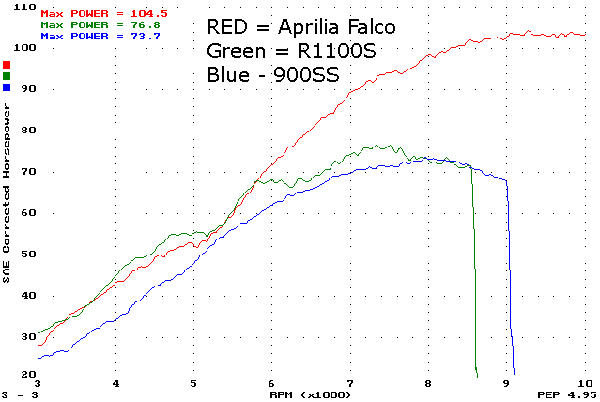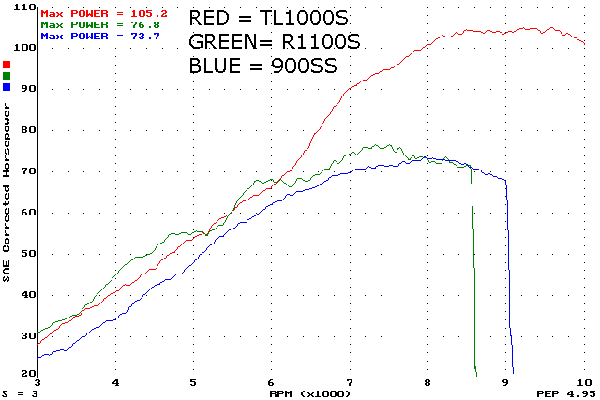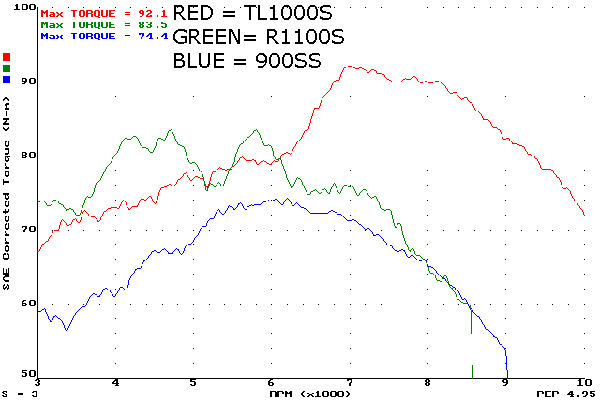The 900SS Ducati is the Italian Marque’s largest capacity ‘SuperSports’ bike. Ducati refers to it’s 748 and 996 range as ‘HyperSports’ models and these two are clearly a step above the ‘SS’ range in performance, with price tags to match.
A two-valve engine is fitted to the 900SS with reasonable bottom and mid-range performance but a lack of a top end urge. Shifting at anything much over around 7,500rpm is wasting time as you are well out of the torque curve by then. Short shifting is the way to make good progress. Check out the dyno charts.

If you are a power fiend this bike will not suit you in the slightest, any Japanese sportsbike of 600cc or above would comprehensively blow its doors off when acceleration enters the equation. The engine does make good bottom end power but the vibes that shudder through the bike when trying to use the bottom end pretty much render it as a pointless exercise. When trying to pull from 2,500 or 3,000rpm so much vibration goes through the bike that it is hard to read the gauges, not to mention use the mirrors.
Some people refer to this as character, I could think of less kinder terms… The injection system is also prone to having a cough in the air box every now and then.
The engine did receive some updates for the 2001 model year which included totally air-cooled cylinders, split timing belt rollers for enhanced set-up accuracy, new KTM oil cooler, new-design clutch master cylinder, new Bosch timing sensor, improved ECU mapping and a new starter motor ratio.
But it must be said that given a tight set of twisties the bottom end of the Ducati will allow it to stay with most bikes. In this situation less experienced riders may well do better on the 900SS than they would on something like a 600-4. The Ducati would probably also improve the skills of the rider as to get the best out of it you have to ride well and concentrate on being smooth and flowing rather than the more frantic riding style that the small Japanese fours lean towards.

The chassis is taut and reasonably hard sprung, with most road irregularities making themselves felt, sometimes a little too harshly. On smooth blacktop the stiff suspension is a big plus but when any bumps enter the equation a rider will feel every one of them. A lot of weight is placed on the wrists/hands and this discomfort is compounded by the hard suspension. Pillion accommodation is typical sportsbike fare, which is of course uncomfortable but no worse than most other sportsbikes. It seems a lot of thought has been put into the design of the seat, which is well padded and excellently shaped, but the harsh ride makes it work hard. With some suspension work to make it a bit more compliant I think it would be quite comfortable in the butt department but the wrists are another matter. I am quite a heavy rider and found the suspension a little stiff so I would think a person of average weight would feel it even more.

I only had the 900SS for a few days but managed to cover over 2,500 kilometres in that time with one day’s jaunt amounting to 1,200 kilometres. Some of these stretches were over 300 kilometres without getting off the bike at all, which highlights the remarkable fuel economy achieved by the Ducati. 320 kilometres before the fuel light came on reminding me that 4 litres were left in the 18-litre tank and I found this to be accurate as I fitted exactly 14 litres into the tank when the light came on. This was speed limit riding in the rain that saw me return 23 kilometres per litre, which is remarkable for a big twin as most of the opposition have woeful fuel economy figures. But it must be said that the opposition bikes also make a lot more power; Suzuki’s little SV650 would give the 900SS a run for its money in acceleration.
Braking is good but requires a little more effort through the lever than most Japanese set-ups. This is a trait I have found fairly constant through most Brembo braking systems, they work well it is just that a harder squeeze is needed to pull the bike up quick. When taking this into account the stoppers work very well indeed with plenty of power.
The dash layout seems very old fashioned by today’s standards but apart from shaking about under vibration they caused me no problems. You only get a tripmeter, speedo, tacho, temp gauge. Warning lights for neutral (it lies a lot), oil, side stand, high beam, indicator and fuel.

Quality of cosmetic finish is generally excellent with the duco deserving a special mention. The Ducati’s red bodywork has to have the best paint finish seen on any motorcycle. I had luggage strapped to the Ducati most of the time with duct tape on the panels to prevent the bags from rubbing the paint away. Even where some of the tape had gone and in other areas where there was no tape to protect the paint, the full surface lustre survived which is quite amazing. I can confidently say that any other bikes paint finish would have either rubbed through or at least have completely lost all its shine. The Ducati was unmarked; the 900SS will stay looking good for many years.
For 2001 the 900SS gained a ‘gun-metal grey’ frame and wheels, metallic silver-grey engine, new rear-view mirrors, grey seat, tank protector and 5-spoke wheels.
I see the 900SS as the bike for someone who doesn’t think they need a lot of power. Maybe a good choice for someone just stepping up to the big-bore class and at a reasonably competitive price.
But keep in mind that servicing is a little more expensive than on the Japanese opposition. The 900SS is a sportsbike where keeping your licence does not have to be a constant battle, but still with enough pull for most on the street.
 Ducati 900SS on the dyno
Ducati 900SS on the dyno
This chart shows the power curves of the Aprilia Falco in red. BMW R1100S in green and Ducati 900SS in blue. The Falco peaks with 104.5 horsepower, the BMW with 76.8 and the 900SS with 73.7.

This chart shows the power curves of the Suzuki TL1000S in red. BMW R1100S in green and Ducati 900SS in blue. The TL1000S peaks with 105.2 horsepower, the BMW with 76.8 and the 900SS with 73.7.

This chart shows the torque curves of the Suzuki TL1000S in red. BMW R1100S in green and Ducati 900SS in blue. The TL1000S peaks with 92.1 N-m, the BMW with 83.5 and the 900SS with 74.4
























